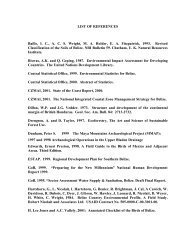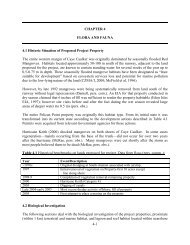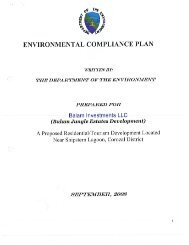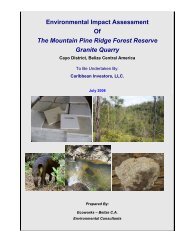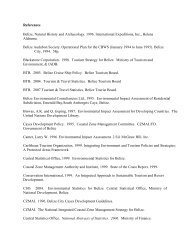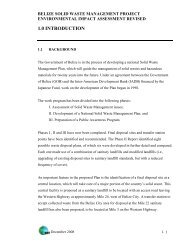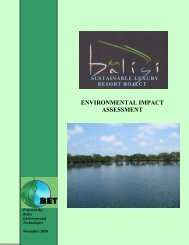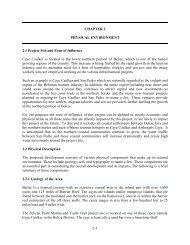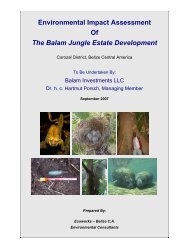Ambergris Caye Belize Resort Development - Department of ...
Ambergris Caye Belize Resort Development - Department of ...
Ambergris Caye Belize Resort Development - Department of ...
You also want an ePaper? Increase the reach of your titles
YUMPU automatically turns print PDFs into web optimized ePapers that Google loves.
3.1.3 Coastal Zone Management Strategy Chap. 329 2000 Revised Edition<br />
The Coastal Zone Management was legally established in 1998 with the passage <strong>of</strong> the Coastal<br />
Zone Management Authority Act (Act # 5 <strong>of</strong> 1998). Under section 5 (1), the main functions <strong>of</strong><br />
the Authority include (i) to advise Government on matters related to development and use <strong>of</strong><br />
resources in the coastal zone in an orderly and sustainable manner; (ii) formulation <strong>of</strong> policies on<br />
coastal zone management; (iii) development <strong>of</strong> a coastal zone management plan and revise it as<br />
needed; (iv) commission monitoring and research <strong>of</strong> coastal areas and; (v) pro mote public<br />
awareness; (vi) prepare guidelines for developers.<br />
The Coastal Zone Management Strategy seeks to facilitate improved management <strong>of</strong> coastal<br />
resources, to ensure economic growth is balanced with sound environmental management<br />
practices. The Strategy seeks to review and ‘enhance existing laws, regulations, ‘policies’ and<br />
guidelines relating to conservation, resource management and development controls in the<br />
coastal zone are.’ These support a coastal area management framework that addresses the need<br />
for management approaches in location between, as well as within, Coastal and marine Protected<br />
Areas, and special requirements for management development and conservation in the barrier<br />
reef region, particularly the cayes.<br />
3.1.4 Effluent Limitation Regulations SI 94/1995<br />
THE ENVIRONMENTAL PROTECTION EFFLUENT LIMITATION REGULATIONS came into force in<br />
1996, at which time the <strong>Department</strong> <strong>of</strong> the Environment commenced enforcing the Regulations.<br />
The Regulations are intended to control and monitor discharges <strong>of</strong> effluent into any inland waters<br />
or the marine environment <strong>of</strong> <strong>Belize</strong>.<br />
3.1.5 Pollution Regulations SI 56/1996<br />
The Pollution Regulations <strong>of</strong> 1996 addresses issues <strong>of</strong> air, water and soil pollution, including<br />
noise pollution. Part III – 6 (1) deals generally with the emission <strong>of</strong> contaminants into the air<br />
where no person shall cause, allow or permit contaminants to be emitted or discharged either<br />
directly or indirectly into the air from any source.<br />
Part X 31 (c & d) deals with pollution <strong>of</strong> land generally that could be harmful, or potentially<br />
harmful to animals, birds, wildlife, plants or vegetation. The <strong>Department</strong> <strong>of</strong> Environment is<br />
responsible for the enforcement <strong>of</strong> the Regulations made Act.<br />
3.1.6 Solid Waste Management Authority Act SI 224 <strong>of</strong> 2000<br />
Under the Act, the Authority shall devise ways and means for the efficient collection and<br />
disposal <strong>of</strong> solid waste employing modern methods and techniques and exploring the possibility<br />
<strong>of</strong> recycling waste materials. Under the Act “construction waste material” includes building<br />
materials from construction, alteration and remodeling building or structure <strong>of</strong> any kind, such as<br />
3-3




